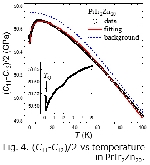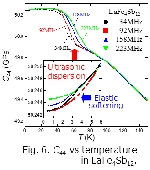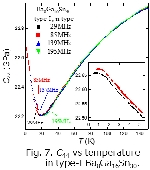Multi-extreme conditions
Strongly correlated electron systems
Research for a novel electronic state originating from strongly correlated electron systems and a large amplitude atomic motion
We focus on a novel electronic state due to strongly correlated electron systems in f-electron and d-electron compounds and a large amplitude atomic motion, which is the so-called rattling motion, under multi-extreme conditions. Our research is performed by measuring the elastic modulus, ultrasonic attenuation, specific heat, magnetization, magnetic susceptibility, and many thermodynamic properties.
Ultrasonic measurement
 The ultrasonic technique (measuring elastic modulus and ultrasonic attenuation) is a powerful tool for studying the novel electronic state arising from strongly correlated electron systems and the rattling motion. The elastic modulus and ultrasonic attenuation can be obtained from the ultrasonic velocity and dissipation of ultrasound, respectively, when ultrasound propagates through the sample. The elastic modulus is a coefficient of a strain to a stress and corresponds to the spring coefficient in the Hooke's law. Generally, the modulus increases monotonically with decreasing temperature in case of no phase transition and no anomalous interaction. Figure 1 shows a simplified block diagram of the elastic modulus measurement system (phase-comparison pulse-echo method).
The ultrasonic technique (measuring elastic modulus and ultrasonic attenuation) is a powerful tool for studying the novel electronic state arising from strongly correlated electron systems and the rattling motion. The elastic modulus and ultrasonic attenuation can be obtained from the ultrasonic velocity and dissipation of ultrasound, respectively, when ultrasound propagates through the sample. The elastic modulus is a coefficient of a strain to a stress and corresponds to the spring coefficient in the Hooke's law. Generally, the modulus increases monotonically with decreasing temperature in case of no phase transition and no anomalous interaction. Figure 1 shows a simplified block diagram of the elastic modulus measurement system (phase-comparison pulse-echo method).  A relative change of the sound velocity in the sample is measured as a relative change of ultrasonic frequency. An example of signal of ultrasonic pulse echoes is shown in Fig. 2.
A relative change of the sound velocity in the sample is measured as a relative change of ultrasonic frequency. An example of signal of ultrasonic pulse echoes is shown in Fig. 2.
Frequency is physical quantity which can be measured with high accuracy. In our laboratory, we have achieved measurement accuracy of 10-7 by improving the feedback system from a conventional analog system to a digital system. In addition, we developed a ultrasonic measurement system: ORPHEUS (Orthogonal Phase-detection Experimental method for Ultra Sound) in collaboration with Yoshizawa laboratory at Iwate University.
On the other hand, it is possible to investigate dynamic properties of the sample, such as the relaxation time, by ultrasonic attenuation. Here, a sound wave has longitudinal or transverse wave characteristic, and the crystal possesses specific symmetry. By a combination of the crystal axis and sound wave, a variety of elastic modes exist. We can assess symmetry of an order parameter by the difference of elastic anomalies among each mode.
Research objects and recent achievements
1. Strongly correlated electron systems
 In lanthanoid and actinoid compounds with high crystal symmetry, localized f-electrons have the charge, spin, and orbital (electric quadrupole) degrees of freedom. The multipolar degrees of freedom often play an important role for the understanding of their physical properties. The electric quadrupole is a second-rank tensor, as with a strain. The strain induced by ultrasound bilinearly couples to a corresponding quadrupole moment. The elastic modulus is quadrupole susceptibility as is the case with magnetic susceptibility which is susceptibility of magnetic dipoles, as shown in Fig. 3. In our laboratory, we are studying f-electron compounds, such as PrIr2Zn20, PrRh2Zn20, TbB4, and UCu2Sn.
In lanthanoid and actinoid compounds with high crystal symmetry, localized f-electrons have the charge, spin, and orbital (electric quadrupole) degrees of freedom. The multipolar degrees of freedom often play an important role for the understanding of their physical properties. The electric quadrupole is a second-rank tensor, as with a strain. The strain induced by ultrasound bilinearly couples to a corresponding quadrupole moment. The elastic modulus is quadrupole susceptibility as is the case with magnetic susceptibility which is susceptibility of magnetic dipoles, as shown in Fig. 3. In our laboratory, we are studying f-electron compounds, such as PrIr2Zn20, PrRh2Zn20, TbB4, and UCu2Sn.
Recent results are as follows. The praseodymium compounds PrTr2Zn20 (Tr=Ir, Rh) undergo a superconducting phase transition at 0.05 K and 0.06 K, respectively. Both compounds also show a phase transition at TQ = 0.11 K (Tr=Ir) and 0.06 K (Tr=Rh) other than the superconducting transition. It was suggested that the transition at TQ is caused by a non-magnetic doublet under a crystal electric field (CEF) in a cubic symmetry. The modulus (C11-C12)/2 is the linear response to the strain corresponding to the non-magnetic doublet. If the non-magnetic doublet is the ground state, remarkable elastic softening of (C11-C12)/2 is expected at low temperatures. We performed ultrasonic measurements in order to clarify the origin of the phase transition at TQ.
 Figure 4 shows the temperature T dependence of the transverse modulus (C11-C12)/2. At high temperatures, (C11-C12)/2 increases monotonically with decreasing T. Below 7 K, elastic softening due to a quadrupole interaction is observed. As shown in the inset of Fig. 4, the softening stops at TQ, and then (C11-C12)/2 turns into increase below TQ, suggesting that most of the quadrupole degrees of freedom disappears at TQ. We performed a theoretical fitting using the CEF effect with a strain-quadrupole coupling and a quadrupole–quadrupole coupling. The red solid curve in Fig. 4 is the best fit, and (C11-C12)/2 is well reproduced. The negative quadrupole–quadrupole coupling constant (g’=-0.13 K) and disappearance of the quadrupole degrees of freedom at TQ indicate that the origin of the transition at TQ is antiferroquadrupolar (AFQ) ordering. In the magnetic field H-temperature phase diagram obtained by ultrasonic measurements in H, TQ increases with increasing H, and then TQ decreases gradually with further increasing H. The re-entrant behavior of TQ also indicates that the transition at TQ is AFQ ordering. We experimentally determined that the phase transition at TQ is AFQ ordering in PrIr2Zn20. Similarly, we also clarified that PrRh2Zn20 undergoes AFQ ordering at TQ.
Figure 4 shows the temperature T dependence of the transverse modulus (C11-C12)/2. At high temperatures, (C11-C12)/2 increases monotonically with decreasing T. Below 7 K, elastic softening due to a quadrupole interaction is observed. As shown in the inset of Fig. 4, the softening stops at TQ, and then (C11-C12)/2 turns into increase below TQ, suggesting that most of the quadrupole degrees of freedom disappears at TQ. We performed a theoretical fitting using the CEF effect with a strain-quadrupole coupling and a quadrupole–quadrupole coupling. The red solid curve in Fig. 4 is the best fit, and (C11-C12)/2 is well reproduced. The negative quadrupole–quadrupole coupling constant (g’=-0.13 K) and disappearance of the quadrupole degrees of freedom at TQ indicate that the origin of the transition at TQ is antiferroquadrupolar (AFQ) ordering. In the magnetic field H-temperature phase diagram obtained by ultrasonic measurements in H, TQ increases with increasing H, and then TQ decreases gradually with further increasing H. The re-entrant behavior of TQ also indicates that the transition at TQ is AFQ ordering. We experimentally determined that the phase transition at TQ is AFQ ordering in PrIr2Zn20. Similarly, we also clarified that PrRh2Zn20 undergoes AFQ ordering at TQ.
Meanwhile, the rare earth tetraboride TbB4 shows two phase transitions at TN1 = 42.1 K and TN2 = 21.7 K. It was reported that the transition at TN1 is magnetic ordering, however, the origin of the transition at TN2 is unclear. We carried out ultrasonic measurements on TbB4 and found a significant softening of (C11-C12)/2 with 45 % reduction of the stiffness at TN2. By the theoretical analysis using the strain susceptibility, the softening is well reproduced and the constant g’ is positive. We experimentally determined that the phase transition at TN2 is ferroquadrupolar ordering in TbB4.
2. The rattling motion
 Cage compounds have attracted much attention because of the so-called rattling motion, which is a large-amplitude atomic motion of the guest atom accommodated in polyhedral cages, as shown in Fig. 5. Thermal conductivity in cage compounds is very low due to phonon scattering by the rattling motion. The cage compounds are expected to be thermoelectric materials which effectively convert waste heat to electricity in terms of application. From the viewpoint of basic study, it is reported that the rattling motion contributes to a novel superconductivity and a metal-insulator phase transition. The physical properties involving the ionic degrees of freedom of the rattling motion, in addition to the charge, spin, and orbital degrees of freedom, have been intensively studied. In our laboratory, we are investigating cage compounds, such as the filled skutterudites RFe4Sb12 (R: rare earth) and intermetallic clathrates A8Ga16C30 (A=Ba, Sr, Eu; C=Ge, Sn).
Cage compounds have attracted much attention because of the so-called rattling motion, which is a large-amplitude atomic motion of the guest atom accommodated in polyhedral cages, as shown in Fig. 5. Thermal conductivity in cage compounds is very low due to phonon scattering by the rattling motion. The cage compounds are expected to be thermoelectric materials which effectively convert waste heat to electricity in terms of application. From the viewpoint of basic study, it is reported that the rattling motion contributes to a novel superconductivity and a metal-insulator phase transition. The physical properties involving the ionic degrees of freedom of the rattling motion, in addition to the charge, spin, and orbital degrees of freedom, have been intensively studied. In our laboratory, we are investigating cage compounds, such as the filled skutterudites RFe4Sb12 (R: rare earth) and intermetallic clathrates A8Ga16C30 (A=Ba, Sr, Eu; C=Ge, Sn).
 In ultrasonic measurements on cage compounds with the rattling motion, ultrasonic dispersion (UD), which is the ultrasonic frequency dependences of elastic modulus and ultrasonic attenuation, and elastic softening at low temperatures are characteristically observed, as shown in Fig. 6. In previous ultrasonic experiments, UD is reported in a particular elastic modulus, suggesting that it possesses ultrasonic mode-selectivity. However, we found UD in all elastic moduli measured in the filled skutterudite LaFe4Sb12. This is the first report on no-mode-selective UD in cage compounds. As for the origin of UD, we semi-quantitatively assessed the strength of electron–phonon coupling using experimental results, the calculated density of states, and the Hattori-Miyake theory. We pointed out that no-mode-selective UD is caused by the coupling between an acoustic phonon and low-lying optical phonon interacting with electrons. The tendency of UD to appear is directly related to the strength of electron-phonon coupling. LaFe4Sb12 has a stronger electron–phonon coupling in all elastic modes.
In ultrasonic measurements on cage compounds with the rattling motion, ultrasonic dispersion (UD), which is the ultrasonic frequency dependences of elastic modulus and ultrasonic attenuation, and elastic softening at low temperatures are characteristically observed, as shown in Fig. 6. In previous ultrasonic experiments, UD is reported in a particular elastic modulus, suggesting that it possesses ultrasonic mode-selectivity. However, we found UD in all elastic moduli measured in the filled skutterudite LaFe4Sb12. This is the first report on no-mode-selective UD in cage compounds. As for the origin of UD, we semi-quantitatively assessed the strength of electron–phonon coupling using experimental results, the calculated density of states, and the Hattori-Miyake theory. We pointed out that no-mode-selective UD is caused by the coupling between an acoustic phonon and low-lying optical phonon interacting with electrons. The tendency of UD to appear is directly related to the strength of electron-phonon coupling. LaFe4Sb12 has a stronger electron–phonon coupling in all elastic modes.
 On the other hand, the type-I clathrate Ba8Ga16Sn30 also has a caged structure. The guest atom locates in four off-center sites from the cage center. Here, the off-center rattling is reported only in type-I clathrates. We carried out ultrasonic measurements on many type-I clathrates and found elastic softening of C44 among the off-center rattling compounds, as shown in Fig. 7. We clarified that the elastic softening originates from the lattice instability by the off-center rattling motion.
On the other hand, the type-I clathrate Ba8Ga16Sn30 also has a caged structure. The guest atom locates in four off-center sites from the cage center. Here, the off-center rattling is reported only in type-I clathrates. We carried out ultrasonic measurements on many type-I clathrates and found elastic softening of C44 among the off-center rattling compounds, as shown in Fig. 7. We clarified that the elastic softening originates from the lattice instability by the off-center rattling motion.
In addition to above researches, we are investigating magnetism, a quadrupole interaction, and the heavy-fermion state in f-electron compounds, such as RT2Al10 (R: rare earth, T=Fe, Ru, Os) and YbMGe (M=Ir, Pt, Rh, Pd, Ge). The rattling motion in the tetrahedrites Cu12-xTMxSb4S13 (TM=Mn, Fe, Co, Ni, Zn), which is expected to be thermoelectric materials consisting of mainly environmentally friendly elements, is studied. We also have an interest in chiral magnetic compounds, such as the green needle and RNi3Ga9.
Multiferroics
同時に複数の秩序を持つ新規物質の探索
In preparation.
研究概要
我々はマルチフェロイックスグループは、鈴木孝至教授のもと、マルチフェロイクスと呼ばれる物質を研究しています。行う実験の方法は
・試料育成
・X線構造解析
・比熱測定
・誘電率測定
・磁化測定
・弾性率測定
など、マルチフェロイックスの特性上多岐にわたっています。
マルチフェロイクスとは
.それでは、マルチフェロイクスとはどの様なものなのでしょうか?
「マルチフェロイクス」という言葉は耳慣れないものであると思います。英語では「multifferoics」、つまり多数の(multi-)強的秩序(ffero-)を持つ物質、ということです。これまで研究が多くされてきたマルチフェロイックスは、強磁性と強誘電性の2つの強秩序を持つものでした。
 マルチフェロイクスの摸式図
マルチフェロイクスの摸式図
しかし我々は、新奇のマルチフェロイクス系、すなわち強誘電性、強磁性、強弾性の3つの強的秩序を併せ持つ物質を探索しています。

上の写真は、私たちが目指す新奇マルチフェロイックス系の候補となり得る物質の単結晶です。純良で大きな単結晶の育成法も開発しました。これら物質群に対し、上で述べた実験をあまねく行っています。
マルチフェロイックス系の魅力は何でしょうか。それは「交差相関」というものです。例えば強誘電体の試料の電気分極を操作したいとき、あなたならどうしますか?普通、試料に電場を加えますよね。これは一般的な電場と分極の相関です。しかし、強誘電性と強磁性を併せ持つ物質においては、磁場をかけることによって分極の操作が可能なのです。更に強弾性を持つ物質が開発されたらどうでしょうか。強弾性とは自発的に歪んでいる状態ですから、応力によって結晶全体の歪みをスイッチすることが出来ます。電場や磁場によって物質の構造を制御したり、応力によってスピンや分極を制御することも可能になります。とても魅力的ですね。
このような物質群が実用化されれば、全く新奇のアクティブデバイスなどへの応用が考えられます。わかりやすい例として、磁気メモリーを電気信号で操作することにより高速化、小型化、省電力化が著しいデバイスなど、様々なブレイクスルーを引き起こすことでしょう。
皆さんも私たちと共に新奇の物性を開拓してみませんか?
